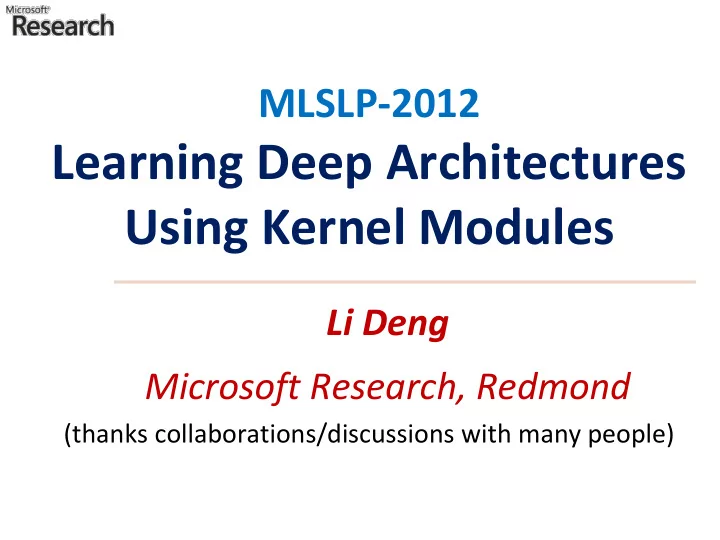

MLSLP ‐ 2012 Learning Deep Architectures Using Kernel Modules Li Deng Microsoft Research, Redmond (thanks collaborations/discussions with many people)
Introduction • Deep neural net (“modern” multilayer perceptron) • Hard to parallelize in learning • Deep Convex Net (Deep Stacking Net) • Limited hidden-layer size and part of parameters not convex in learning • (Tensor DSN/DCN) and Kernel DCN • K-DCN: combines elegance of kernel methods and high performance of deep learning • Linearity of pattern functions (kernel) and nonlinearity in deep nets
Deep Neural Networks 3
4
5
Deep Stacking Network (DSN) • “Stacked generalization” in machine learning: – Use a high-level model to combine low-level models – Aim to achieve greater predictive accuracy • This principle has been reduced to practice: – Learning parameters in DSN/DCN (Deng & Yu, Interspeech- 2011; Deng, Yu, Platt, ICASSP-2012) – Parallelizable, scalable learning (Deng, Hutchinson, Yu, Interspeech-2012)
. DSN/DCN Architecture . . Example: L=3 • Many modules • Still easily trainable 10 10 • Alternating linear & nonlinear sub-layers 3000 3000 • Actual architecture for digit image recognition (10 classes) 10 784 10 784 • MNIST: 0.83% error rate (LeCun’s MNIST site) 3000 3000 10 784 10 784 3000 3000 784 784
Anatomy of a Module in DCN targets 10 10 10 10 3000 3000 U=pinv(h)t 10 784 10 784 h 3000 3000 10 784 10 784 W rand W RBM 3000 3000 784 linear units 10 linear units 784 linear units 10 linear units x 784 784
From DCN to Kernel-DCN Predictions � ��� � ��� � ��� ��� �� � �� ��� � � ��� Preds � ��� Preds � ��� � ��� Input Data X � ��� � ��� � ��� ��� �� � �� ��� � � ��� Prediction � ��� Input Data X � ��� � ��� � ��� � ����� � ���; � ∈ � � � ��� � ��� Input Data �
Kernel-DCN
Nystrom Woodbury Approximation C
K-DSN Using Reduced Rank Kernel Regression
K-DCN: Layer-Wise Regularization Predictions • Two hyper-parameters in each module • Tuning them using cross validation data � ��� • Relaxation at lower modules � ��� � ��� ��� �� � �� ��� � • Special regularization procedures � ��� • Lower-modules vs. higher modules Preds � ��� Preds � ��� � ��� Input Data X � ��� � ��� � ��� ��� �� � �� ��� � � ��� Prediction � ��� Input Data X � ��� � ��� � ��� � ����� � ���; � ∈ � � � ��� � ��� Input Data �
USE OF KERNEL DEEP CONVEX NETWORKS AND END-TO-END SLT-2012 paper: LEARNING FOR SPOKEN LANGUAGE UNDERSTANDING Li Deng 1 , Gokhan Tur 1,2 , Xiaodong He 1 , and Dilek Hakkani-Tur 1,2 1 Microsoft Research, Redmond, WA, USA 2 Conversational Systems Lab, Microsoft, Sunnyvale, CA, USA Table 2 . Comparisons of the domain classification error rates among the boosting-based baseline system, DCN system, and K- DCN system for a domain classification task. Three types of raw features (lexical, query clicks, and name entities) and four ways of their combinations are used for the evaluation as shown in four rows of the table. Feature Sets Baseline DCN K-DCN lexical features 10.40% 10.09% 9.52% lexical features 9.40% 9.32% 8.88% + Named Entities lexical features 8.50% 7.43% 5.94% + Query clicks lexical features 10.10% 7.26% 5.89% + Query clicks + Named Entities
Table 3 . More detailed results of K-DCN in Table 2 with Lexical+QueryClick features. Domain classification error rates (percent) on Train set, Dev set, and Test set as a function of the depth of the K-DCN. Depth Train Err% Dev Error% Test Err% 1 9.54 12.90 12.20 6.36 10.50 9.99 2 3 4.12 9.25 8.25 4 1.39 7.00 7.20 0.28 6.50 5.94 5 6 0.26 6.45 5.94 7 0.26 6.55 6.26 8 0.27 6.60 6.20 0.28 6.55 6.26 9 10 0.26 7.00 6.47 0.28 6.85 6.41 11
Recommend
More recommend